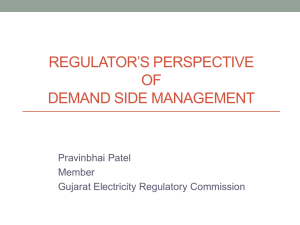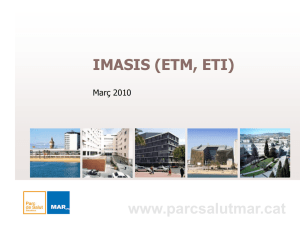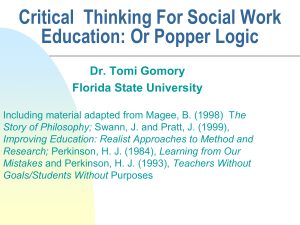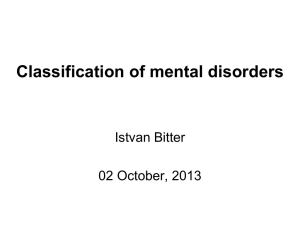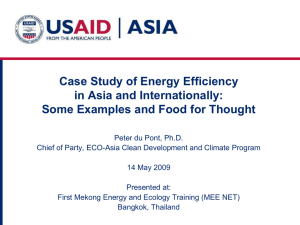conf. presentation - Department of Civil Engineering
advertisement
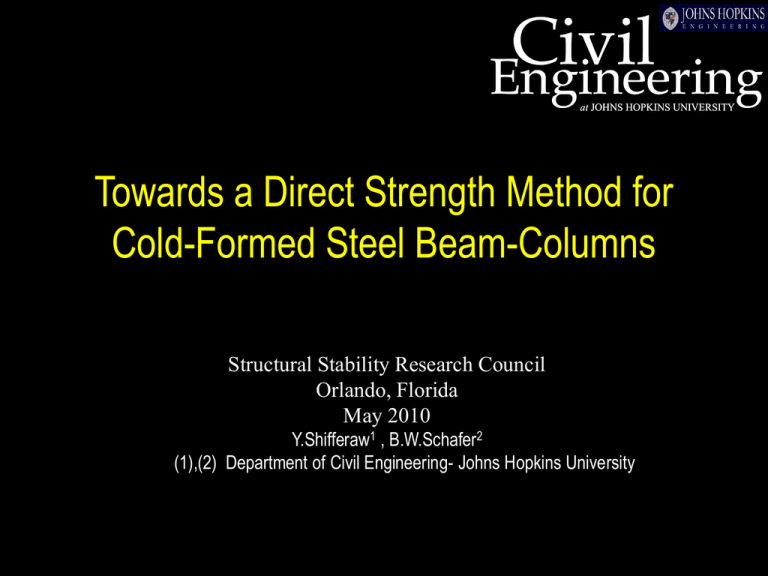
Civil Engineering at JOHNS HOPKINS UNIVERSITY Towards a Direct Strength Method for Cold-Formed Steel Beam-Columns Structural Stability Research Council Orlando, Florida May 2010 Y.Shifferaw1 , B.W.Schafer2 (1),(2) Department of Civil Engineering- Johns Hopkins University Acknowledgments • National Science Foundation Overview • Introduction • Basis of DSM: yield and elastic critical buckling • Finite element collapse analysis in the P-M space • Direct Strength Method preliminaries for local and distortional buckling in the P-M space • Conclusion • Future research Introduction • Current and postulated beam-column design approaches DSM anchor pts DSM Yieldanchor pts Yield Dis cr Dis cr Interaction Interaction 70 70 P P cr , d 60 cr , d Py 60 50 50 P Pn n 40 40 Postulated n curve Postulated nM curve for all P and ratios for all P and M ratios cr , d cr , d y y n 30 30 20 20 Postulated for a Postulated for given P and Maratio given P and M ratio n 10 10 0 0 0 0 50 50 M M n n 100 100 My 150 150 M M cr , d cr , d 200 200 Sections considered 1.75 in 1 in. 250 1.625 in. 0.5 in. 3.625 in. 6 in. 0.5 in. 1 in. 2 in. Eave Strut 1.625 in. Channel t=0.08in. fy=55.9 ksi DSM basis: major axis yielding and elastic buckling 362Cmajor 2 First yield Loc cr 1.5 Dist cr 1 P/P y 0.5 0 -0.5 -1 -1.5 -2 -2 -1.5 -1 -0.5 0 Mx /Mx,y 0.5 1 1.5 2 DSM basis: minor axis yielding and elastic buckling 362Cminor 2 First yield Loc cr 1.5 Dist cr 1 P/P y 0.5 0 -0.5 -1 -1.5 -2 -2 -1.5 -1 -0.5 0 Mz /Mz,y 0.5 1 1.5 2 DSM basis: biaxial yielding and elastic buckling 362Cbiaxial 2 First yield Loc cr 1.5 Dist cr 1 0 x M /M x,y 0.5 -0.5 -1 -1.5 -2 -2 -1.5 -1 -0.5 0 Mz /Mz,y 0.5 1 1.5 2 Finite element modeling • Objective To study combined P-M collapse loads in CFS beam-columns for local and distortional limit states. • Method – Material and geometric nonlinear analysis in ABAQUS using S9R5 shell element models; geometric local and distortional imperfections considered – Models generated from purpose-built Matlab code Local FE Major axis local for channel 1 FE Analysis Ultimate Bounding Surface 0.9 0.8 0.7 P/P y 0.6 0.5 0.4 0.3 0.2 0.1 0 -1.5 -1 -0.5 0 Mx /Mx,y 0.5 1 1.5 Major axis local for eave strut 1 FE Analysis Ultimate Bounding Surface 0.9 0.8 0.7 P/P y 0.6 0.5 0.4 0.3 0.2 0.1 0 -1.5 -1 -0.5 0 Mx /Mx,y 0.5 1 1.5 Distortional FE Minor axis distortional for channel section 1 FE Analysis Ultimate Bounding Surface 0.9 0.8 0.7 P/P y 0.6 0.5 0.4 0.3 0.2 0.1 0 -1.5 -1 -0.5 0 Mz /Mz,y 0.5 1 1.5 Minor axis distortional for eave strut section 1 FE Analysis Ultimate Bounding Surface 0.9 0.8 0.7 P/P y 0.6 0.5 0.4 0.3 0.2 0.1 0 -1.5 -1 -0.5 0 Mz /Mz,y 0.5 1 1.5 Overview • Introduction • Basis of DSM: yield and elastic critical buckling • Finite element collapse analysis in the P-M space • Direct Strength Method preliminaries for local and distortional buckling in the P-M space • Conclusion • Future research M nd M y M p M y 1 d dy 2 Preliminary DSM beam-column strength prediction LOCAL if 0.776, n ne if 0.776, 0.4 0 .4 cr cr y n 1 0.15 y y where y cr 0 .5 Local DSM vs major axis strength bounds for channel DSM vs Strength Bounds-362Cloc,major 1 FE-Loc DSM anchor pts 0.9 Y ield Loc cr 0.8 DSM proposed Interaction 0.7 P/P y 0.6 0.5 0.4 0.3 0.2 0.1 0 -1.5 -1 -0.5 0 Mx /Mx,y 0.5 1 1.5 Local DSM vs minor axis strength bounds for channel DSM vs Strength Bounds-362Cloc,minor 1 FE-Loc DSM anchor pts 0.9 Y ield Loc cr 0.8 DSM proposed Interaction 0.7 P/P y 0.6 0.5 0.4 0.3 0.2 0.1 0 -1.5 -1 -0.5 0 Mz /Mz,y 0.5 1 1.5 Local DSM vs major axis strength bounds for eave DSM vs Strength Bounds-E loc,major 1 FE-Loc DSM anchor pts 0.9 Y ield Loc cr 0.8 DSM proposed Interaction 0.7 P/P y 0.6 0.5 0.4 0.3 0.2 0.1 0 -1.5 -1 -0.5 0 Mx /Mx,y 0.5 1 1.5 Local DSM vs minor axis strength bounds for eave DSM vs Strength Bounds-E loc,minor 1 FE-Loc DSM anchor pts 0.9 Y ield Loc cr 0.8 DSM proposed Interaction 0.7 P/P y 0.6 0.5 0.4 0.3 0.2 0.1 0 -1.5 -1 -0.5 0 Mz /Mz,y 0.5 1 1.5 M nd M y M p M y 1 d dy 2 Preliminary DSM beam-column strength prediction DISTORTIONAL if d 0.673c, nd y if d 0.673c, cr nd 1 0.22a d y where 0.5b cr d y 0.5b y 0.5 y d cr d a (1.136)^ (2 , b (1.2)^ (2 , c (0.834)^ (2 angular direction in radians in the P M space Distortional DSM vs major axis strength bounds for channel DSM vs Strength Bounds-362Cd,major 1 FE-Dist p FE-Dist n 0.9 DSM anchor pts Y ield 0.8 Dist cr DSM proposed 0.7 Interaction P/P y 0.6 0.5 0.4 0.3 0.2 0.1 0 -1.5 -1 -0.5 0 Mx /Mx,y 0.5 1 1.5 Distortional DSM vs minor axis strength bounds for channel DSM vs Strength Bounds-362Cd,minor 1 FE-Dist p FE-Dist n 0.9 DSM anchor pts Y ield 0.8 Dist cr DSM proposed 0.7 Interaction P/P y 0.6 0.5 0.4 0.3 0.2 0.1 0 -1.5 -1 -0.5 0 Mz /Mz,y 0.5 1 1.5 Distortional DSM vs major axis strength bounds for eave DSM vs Strength Bounds-E d,major 1 FE-Dist p FE-Dist n 0.9 DSM anchor pts Y ield 0.8 Dist cr DSM proposed 0.7 Interaction P/P y 0.6 0.5 0.4 0.3 0.2 0.1 0 -1.5 -1 -0.5 0 Mx /Mx,y 0.5 1 1.5 Distortional DSM vs minor axis strength bounds for eave DSM vs Strength Bounds-E d,minor 1 FE-Dist p FE-Dist n 0.9 DSM anchor pts Y ield 0.8 Dist cr DSM proposed 0.7 Interaction P/P y 0.6 0.5 0.4 0.3 0.2 0.1 0 -1.5 -1 -0.5 0 Mz /Mz,y 0.5 1 1.5 Conclusion • Under combined loading the assumptions in linear interaction equations are invalidated in CFS members due to – Un-symmetric shapes of common CFS sections – Consideration of cross-section stability • Finite element models for local and distortional models are developed to examine load-bending collapse envelopes. • Preliminary Direct Strength Method design expressions for beam-columns in local and distortional buckling as a function of elastic section slenderness are established and compared with the FE models developed. • Significant efficiency in the proposed DSM approach in comparison with traditional design. Future work • Incorporation of recently proposed inelastic bending provisions • Further preliminary studies including global buckling • Beam-column tests • Comprehensive FE parametric study • Formal DSM proposals for beam-columns ?


